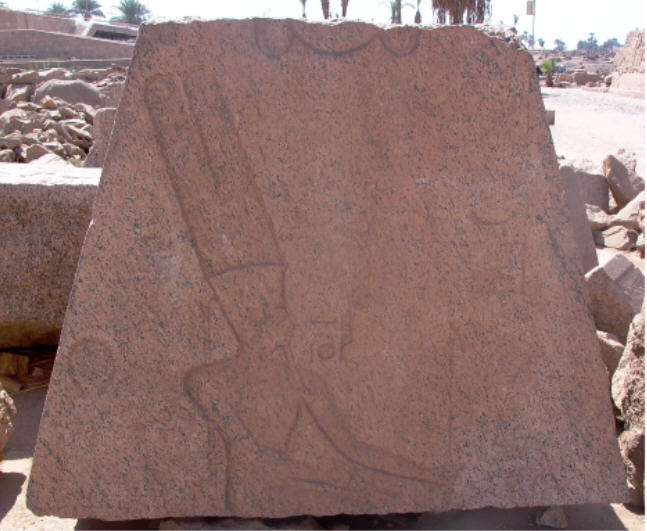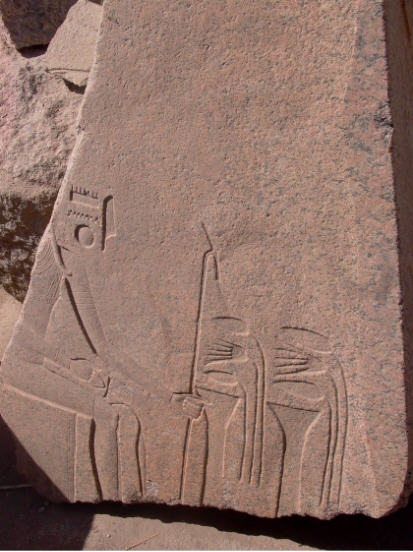|
Karnak-Temple Obelisks |
last update:
22.04.2013
|
| |
The Obelisks of Hatshepsut
|
|
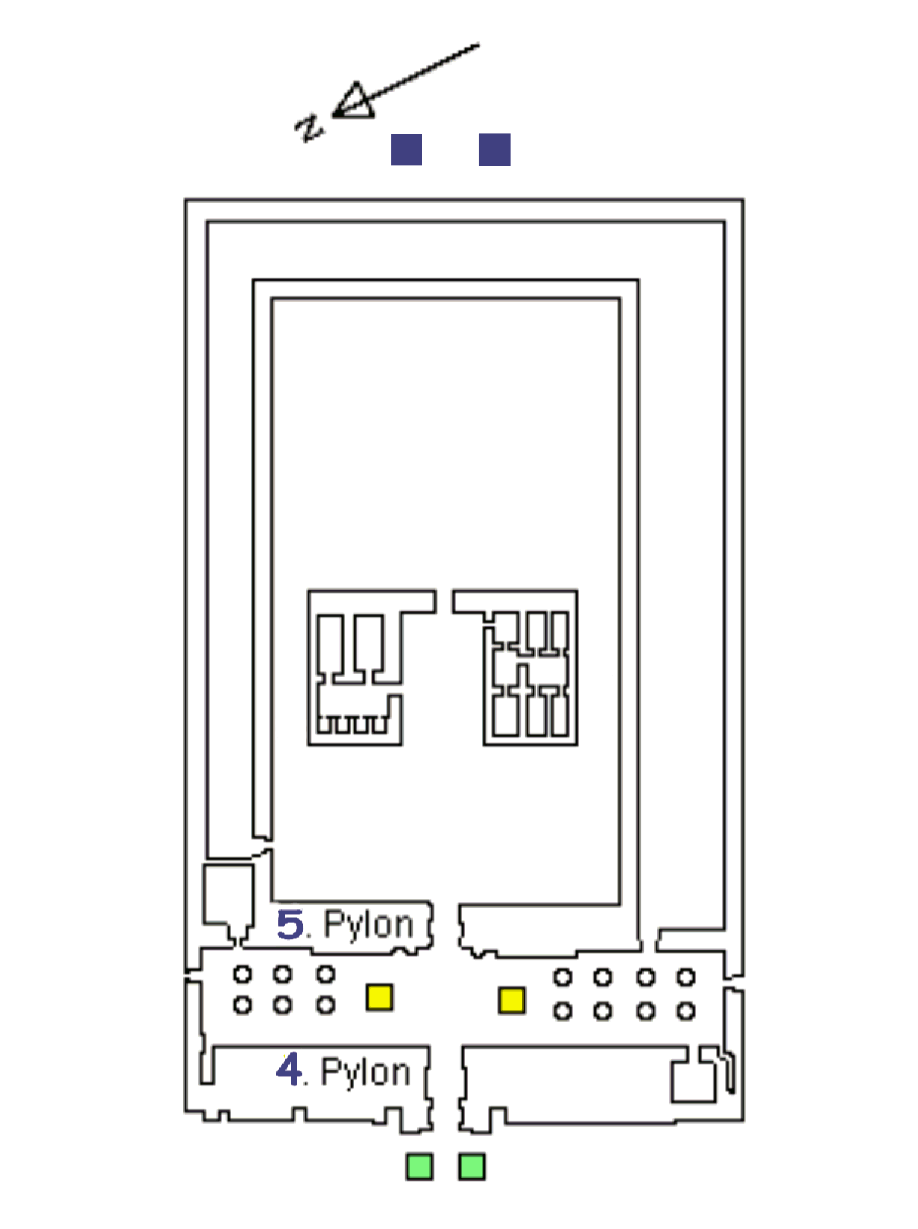
Floor plan of Ip.t-Sw.t ("Elected Place",
modern-day Karnak) at the times of Hatshepsut; with the
Chambers of Hatshepsut;
in Yellow, the two obelisks of Hatshepsut between pylons 4 and 5;
in Green, the two obelisks of Thutmosis I in front of the 4. Pylon
in Blue, the first pair of obelisks erected by Hatshepsut eastwards behind the
central area of the temple of Karnak
|
| So far, it was assumed that Hatshepsut had erected two pairs of
obelisks. However, according to the latest results of the exploration of the
Karnak Temple by the CFEETK this assumption must be dismissed. |
| As reported by Larché (Larché, Cahiers de Karnak XIII, 2010),
investigations of the foundations of the pairs of obelisks of Thutmose I and II
in front of the 4th pylon showed that the four bases of the two pairs were built
on two common foundations North and South of the axis of the temple. On the
other hand, the obelisks of Thutmosis III were erected west of these on separate
foundations. The investigation of the stone layers showed that the two pairs of
foundations for the obelisks of Thutmose I and II together had to been built at
the same time. |

| The figure taken from Larché, Cahiers de Karnak XII, 2007,
plate LXXXII, shows a section through the temple at the time of Hatshepsut. Seen
from the South the two (pairs) of obelisks of Thutmosis II (left) and I (right)
are shown in front of the 4th pylon. Between the 4th pylon and the part of 5th
pylon the illustration shows the Wadjit Hall. The two pairs obelisks West of the
4th pylon were erected on a common foundations. |
| According to the Fig. 3, p. 318 (Larché, Cahiers de Karnak
XIII, 2010) a quartzite block of a foundation carries several cartouche with the
throne name of Hatshepsut, i.e. the foundation must built have been after her
accession to the throne. |
| Based on these findings Larché (2010) assumes: |
| - that Thutmosis I quarried two obelisks from Aswan but they
were never erected at Karnak during his lifetime.
|
| - that Hatshepsut used the obelisks of her father which were
probably lying somewhere on the ground at Karnak and erected them together with
a pair of obelisks decorated in the names of her husband Thutmosis I and herself
in front of the 4. pylon. On the eastern end of two large foundations she
erected the obelisks of her father and, on the western ends, the pair decorated
in the names of Thutmosis II and herself. |
| - that probably these two pairs of obelisks are those depicted
on the wall of the southern wing of the 1st portico of her temple Djeser
djeseru. |
| - that Thutmosis III during the time of the "proscription" of Hatshepsut
erased her throne name on the obelisks of Thutmosis II./Hatshepsut and replaced
it with the name of his father. |
| - that the pair of obelisks of Thutmosis II/Hatshepsut and the
pair erected by Tuthmosis III west of them have been removed by Amenhotep III to
make room for the current 3rd pylon. Both pairs of obelisks were then "buried"
somewhere in the temple area, so that they were not accessible for the
iconoclasts of the Amarna period (because their depictions of Amun are intact -
unlike the obelisks of Thutmose I and Hatshepsut). This also explains why in
side view (from West to East) of the temple of Karnak in the tomb of Neferhotep
(TT49) only one pair of obelisks - that of Thutmose I - is depicted in
front of the 4th pylon. Neferhotep, "First scribe of Amun", dates in the time of
Tutankhamun and Horemheb - at that time the obelisks of Thutmosis II/Hatshepsut
and Thutmose III did not stand anymore. |

| Part a wall scene from the tomb of Neferhotep, TT49 (from:
Davies, the tomb of Nefer-Hotep at Thèbes. New York 1973, plate III). The scen shows from left to right: the
river Nile with ships, a T-shaped harbor, then the
3rd pylon with its flag-poles, further to the East (right) the pair of
obelisks of Thutmose I and the gate of the 4th pylon, far right, the "Palace of Maat". |
| The first pair of obelisks of Hatshepsut was erected at the eastern side of the
temple of Amun. Today, from both obelisks only parts of the destroyed and
uninscribed bases and the foundations have survived at the eastern side of the
temple (see below). One pyramidion has been mounted in front of the Egyptian
Museum at Cairo, parts of the 2nd pyramidion have been mounted a few meters away
in a storage place. |
| The first pair of obelisks had been produced
under the direction of Senenmut. The so-called Graffito of Senenmut (see
picture below) cut into the rock on the island Sehel at Aswan, opposite the island Elephantine, reminds of
this.
The graffito shows on the left side Senenmut standing in an attitude
of admiration in front of Hatshepsut. On the right side Hatshepsut
portrayed in female garb carrying a double plume headdress or crown, in the right hand
she is holding a scepter (Hts) and in the left
an Ankh-(anX)-sign. Hatshepsut does not carry
an uraeus at the crown, which is to possibly due to a bad execution of the
Graffito or to an unsatisfactory preservation of the same.
|
| The accompanying inscriptions consists the three logical blocks, whereby the upper 6 registers belong to
Hatshepsut, the three registers arranged between both persons contains the legend
of Senenmut, and the four registers arranged below the two persons give
the final report of Senenmut concerning the execution of the work on
both obelisks (viz. Meyer, 1982, Niedziólka, 1999).
|
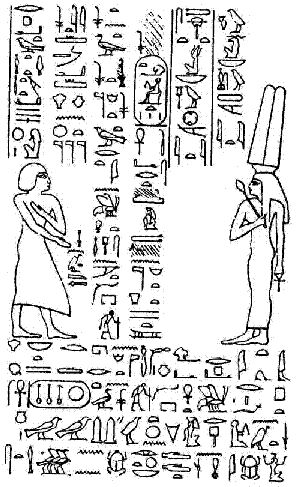
The inscription concerning Hatshepsut reads:
"Rpat, hereditary
princess (HAtja), great of praise and charm, great of love, one to whom Ra has
given the kingship, righteously in the opinion of the Ennead of gods,
king's daughter, king's sister, god's wife, great king's wife, [lady of
the Nile Valley and Delta, Hatshepsut, may she live, beloved of Satet,
lady of Elephantine, beloved of Khnum, lord of the 1st Cataract region." |
|
The paragraph
"one to whom Ra has given the kingship" is of course
the most disputed part of the graffito. In the publications concerning the
graffito different copies of the corresponding hieroglyphics had been
presented. Even after the quasi-facsimile copy published by Habachi (1957; quoted after Niedziólka, 1999)
the interpretation of that part is still different - particularly with
regard to the historical dating of Accession
to the Throne.
|
The inscription concerning Senenmut reads (Niedziólka, 1999):
"Presentation of this work to the god's wife, Mistress of
the complete Two Lands by the seal-bearer of the king of Lower Egypt (xtmtj-bitj),
a great and beloved [friend (smr watj)]
, the great steward (jmj-rA pr wr),
Senenmut, true of voices."
|
The inscription below the persons reads:
"The coming (done) by a hereditary prince, local prince,
great confidant of the god's wife, one with whose utterance the lady of
the Two Lands is content, a seal-bearer of the king of the Lower Egypt (sDAwtj-bitj),
great steward (jmj-rA pr wr)
of the king's daughter, Neferu-Ra, may she live, Senenmut, in
order to lead the works on the two great obelisks of million of years.
Then (it) happened as that, what is ordered, and everything has been
made, and it was because of the power her majesty that (it) happened." |
|
The entire text is quite confusing, because Hatshepsut is specified here with
the title and insignia - the scepter in the right hand - of a "God's
Wife". Furthermore, she carries a long dress and the double-plume crown of the first royal wife, but Senenmut describes
her as the lady "to whom her father Ra has given the kingship" -
one may ask oneself whether he flatters her or whether he already points
towards the future.
|
| It is generally agreed that the graffito addresses the first pair
of obelisks which Hatshepsut had erected at the eastern side of the temple
of Amun. The allocation to the early obelisks is based on the specification
given on the basis of the two other obelisks between 4. and 5. Pylon, which date their
erection into year 16.
|
|
Later, both obelisks became part of the new enclosure wall around the central
district of Karnak.
|
| From these two obelisks only fragments are
remaining, most of it are today mounted not far from the original location of the
obelisks. Completely preserved is the pyramidion of the northern of the two
obelisks which was discovered 1861 at Karnak (Niedziólka, 2000). In 1884 Boulaq
(Varille, 1950) transported the pyramidion which is about 3 m in height to Cairo
where it is exhibited in the garden in front of the Egyptian Museum. A fragment of the
pyramidion of the 2nd, southern obelisk which decoration is partially
preserved on three pages is to be seen today at Karnak (eastwards from
the "Festival Hall" of Thutmosis III, together with the
aforementioned fragments).
|
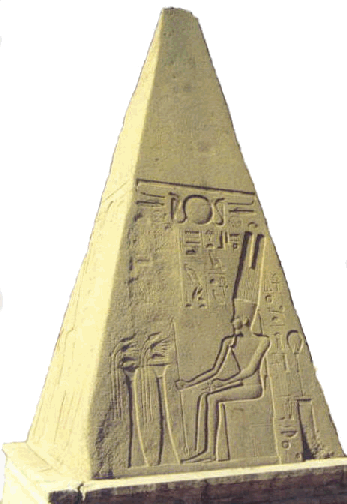
| Above the preserved pyramidion of the northern obelisks of the
1. Pair of Hatshepsut. Today, this pyramidion is exhibited in the garden in
front of the Egyptian Museum, Cairo. |
| Both obelisks had been altered for
the 1st time by Thutmosis III - the figure of Hatshepsut had been
erased and was replaced by two offering stands.
Inevitable, the presentation of Amun had to be changed -
instead of the crown he held above the head of the queen he now holds
a scepter and an anx (Habachi, 2000) |
| Later, the Amarna iconoclasts destroyed the figure of Amun
which was restored in Ramesside times as demonstrated by the remains of a
typical restoration formula (Varelli, 1950). |
| Above the destroyed pyramidion of the second, southern
obelisk, its decoration has partially survived. Today, this pyramidion
is stored near the original place of the obelisk in Karnak (in the background the grandstand for the
"Sound and Light-Show" at the holy lake). The first photo shows a relatively well
preserved side with the figure of Amun, the second photo shows the
preserved part of the left side (in relation to the photo above). As is the case for the
pyramidion exhibited in Cairo the photo shows that also here the figure of
Hatshepsut was erased and replaced by a table with offerings . |
| The titles ("Great Royal Wife", "God's Wife")
of Hatshepsut clearly show that she still exercised the regency for Thutmosis
III at the
time the two early obelisks were ordered and produced in the quarry. According
to Meyer (1982) however, their inscription and erection must have taken place after
the accession of Hatshepsut because the decoration of the pyramidion
show - although they had been modified - the coronation of Hatshepsut by Amun.
This points on the fact that the first two obelisks had been erected
on the occasion of her accession to the throne - and possibly had been
ordered intentionally for this event. Their transport by ship and
the erection of both obelisks at Karnak is shown in detail in the so-called
"Hall of Obelisks" in the 1.
portico of the temple of Hatshepsut, Djeser djeseru, at Deir el-Bahari.
|
| Not only the obelisks but also the bases of both are markedly
destroyed
(see photos below). However, on both bases the grooves which were used to erect
the obelisks still ca bee seen. Theses grooves clearly show that the obelisks
had been erected from the north or the south side respectively. |
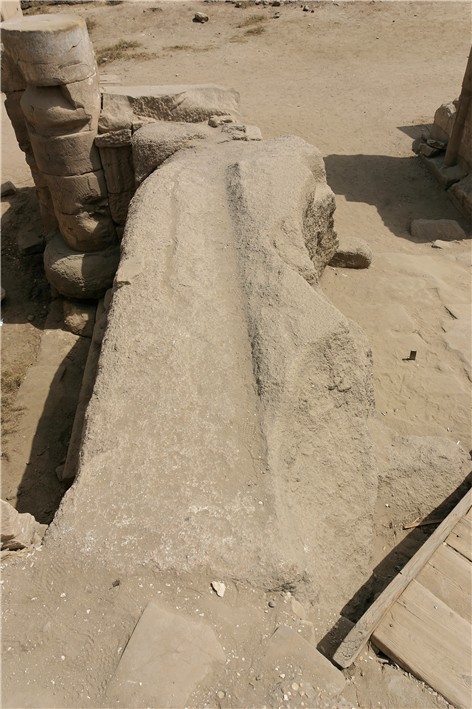
| Above, the remains of the northern basis with the groove on
its northern side. Below the remains of the southern basis, this photo was taken
from the east side of the basis so the groove is visible as a deepening on the
south side of the block |
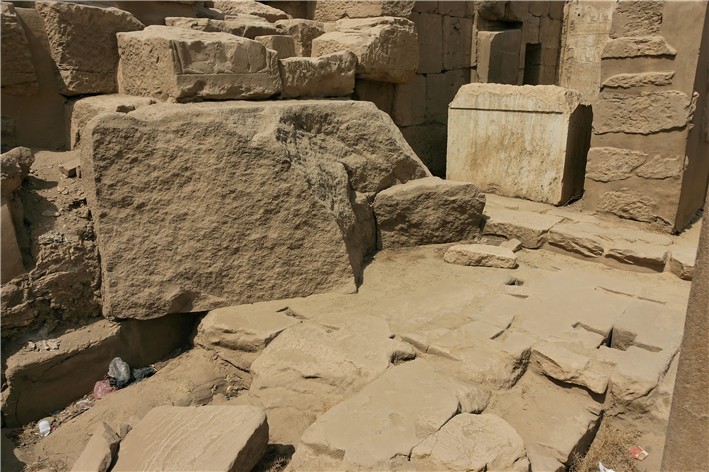
|
The columned hall built by Thutmosis I between 4. and 5. Pylon, was
changed in the reign of Hatshepsut, whereby on the right of and on the left of the passage
her second pair of obelisks made from granite was erected on the
occasion of her jubilee ("heb- sed" jubilee) in year 16. |
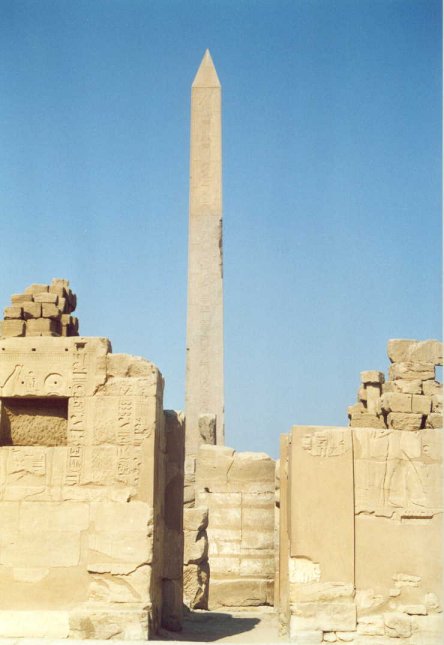
| Above the still standing obelisk of the second pair of
Hatshepsut (height of 28.48 m; Weight: 323 t); the somewhat darker color of the lower section
indicates, up to which height the obelisks had been encased later by the
restoration of the Hall of Wadjit initiated by Thutmosis III - up to this height
the obelisks had been protected against bleaching sunbeams. |
| Today, one of the two obelisks is still standing at its
original place (photo above), the second has fallen down and is broken
into pieces, the upper part is mounted on concrete blocks in the proximity of the holy
lake (see left photo below). |
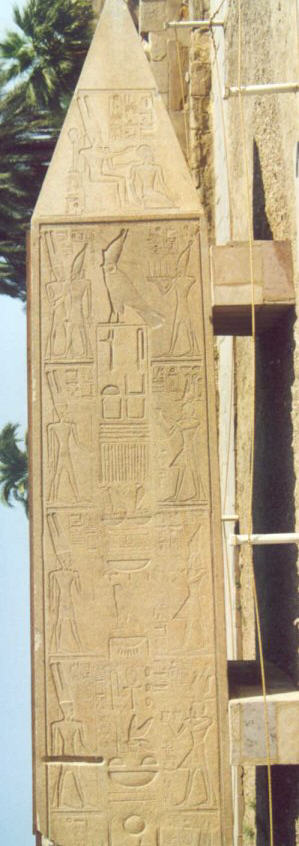 |
|
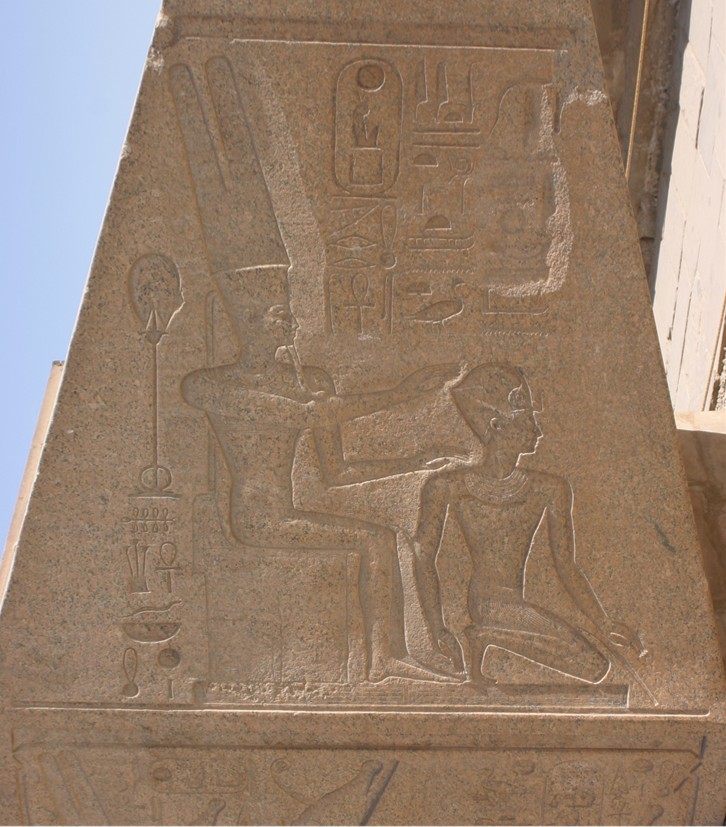
Above a detail of the pyramidion of the broken obelisk. Due to
light which comes in diagonally the part clearly shows that figure and name of Amun had been erased in the
Amarna period and were renewed later - both are situated somewhat more deeply than the
surrounding surface of the relief.
Here a remarkable difference is discernible between the "persecution" of Hatshepsut by Thutmosis III and that of Amun in the Amarna period:
Thutmosis III let immure the obelisks of Hatshepsut during restoration
and roofing of the Wadjit-hall, but otherwise the obelisks were
not affected. However, in the Amarna period no efforts were spared
to reach the pyramidion of the obelisks to remove the covering of
electrum and to destroy the relief thereafter. |
| The upper part of the broken obelisks of
Hatshepsut, laid out near the holy lake of Karnak (picture turned by
90°). |
|
This pair of obelisks was produced from granite on the island Sehel at Aswan
under the supervision of the steward
Amen-hotep. These
obelisks were erected and their upper half covered with electrum under
the supervision of Djehutj,
Director of the Treasury, who gave a report about his duties on
the "Northampton-Stela". A relief of the Red Chapel
reports about the donation of these two obelisks (s. there).
|
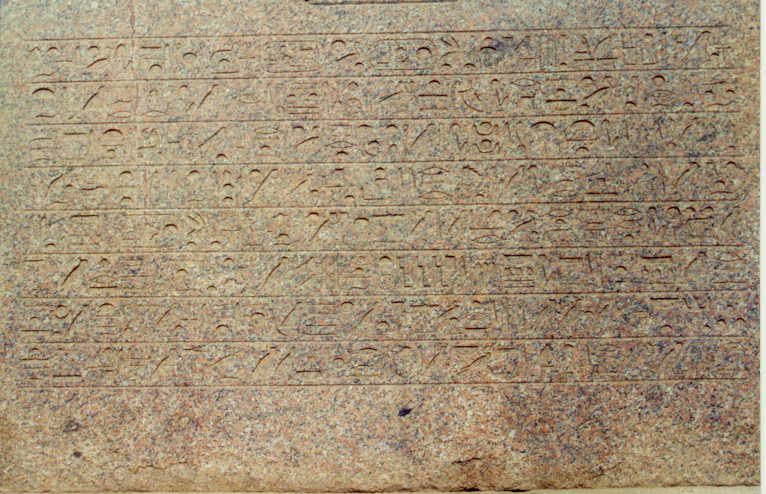
|
At the base of the still standing obelisk of Hatshepsut the inscriptions again
describe on all 4 pages the production and erection of the obelisks (the photo above
shows the western side of the base). On the base of the destroyed obelisk
Hatshepsut praises herself that "the black and the red country" are
her subject and the south boundary of her rule would be located in Punt.
|
|
The following pictures show the sides of the still-standing obelisk (according
to drawings of Bell, 1999) in the order (from left to right): northern,
western, southern, and eastern side.
|
|
The following 4 paragraphs show the central line of text on each side in
the order of the pictures above (N, W, S, O), the hieroglyphic
inscriptions are based on Sethe (1927/1930),the translations on
Blumenthal, E., Müller, I., Reineke, W.F. (1984):
|
|
Northern side (left side): Horus "Powerful of Kas",
the Two Ladies "Flourishing of Years", Golden Horus "Divine of Appearances",
King of Upper and Lower Egypt and Lord of the Two Lands
"Maat-Ka-Ra". Her father Amun had established her great name
"Maat-Ka-Ra" on the Ished tree, her annals are million of years,
duration and power, son of Ra
"Hatshepsut, unified with Amun", beloved of Amun-Ra, King of the
Gods, as [reward for this good, enduring and excellent monument], that she
had donated to him (at the occasion) of the first royal jubilee (= sed
festival). Mays she live forever.
|
|
Western side (front): Horus "Powerful of Kas", the
Two Ladies "Flourishing of Years", Golden Horus "Divine of Appearances",
King of Upper and Lower Egypt and Lord of the Two Lands "Maat-Ka-Ra".
She made (it) as her monument for her father
Amun, Lord of the Throne of the Two Lands, erecting for him two large obelisks
at the great gate [note =Pylon) "Amun is Great in-Terror",
wrought with very much electrum, which illuminates the Two Lands like the
sun. Never was the like made on earth since the beginning. It was done for
him (=Amun) by the sun of Ra "Hatshepsut, unified with Amun",
may she live forever like Ra.
|
|
Southern side (right side): Horus "Powerful of Kas",
King of Upper and Lower Egypt "Maat-Ka-Ra", brilliant emanation
of Amun, whom he has caused to appear as king upon the throne of Horus
"Holy of Holiest" (note
= Djeser djeseru) of the Great House, whom the ennead of gods have brought
up to be mistress of the circuit of the sun. They have united her with
life, power and joy of the heart, the First of the Livings, son of Ra "Hatshepsut,
unified with Amun", beloved of
Amun-Ra, King of the Gods, may he (note = Hatshepsut) live forever like Ra.
|
|
Eastern side (back): Horus "Powerful of Kas", King of
Upper and Lower Egypt "Maat-Ka-Ra", beloved of Amun-Ra. Her
majesty has made the name of her father established on this enduring
monument, so that the King of Upper and Lower Egypt and Lord of the Two
Lands "Aa-kheper-ka-Ra" (= Thutmosis I) will be praised by the
majesty of this god, when the two great obelisks were erected by her
majesty on the first time (note: of her royal jubilee).
The King of Gods (Amun) said: "Your (fem.) father, the King of
Upper and Lower Egypt "Aa-kheper-ka-Ra" had given the command to
erect obelisks. Your (fem.) majesty will repeat the monuments. (So that)
you may live forever."
|
|





